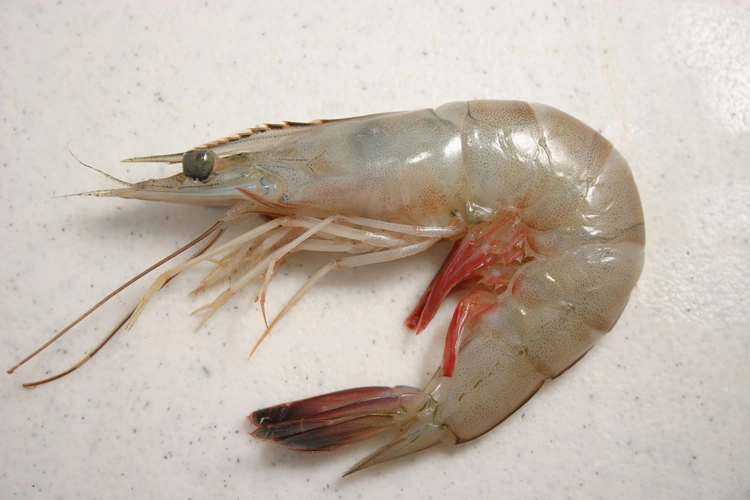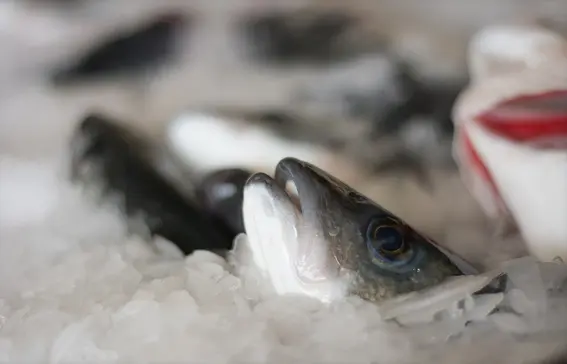Our Farmed Seafood
Farmed Seafood Product List
-
Sea Bass
-
Sea Bream
-
Red Porgy
-
Meagre
-
Great Amberjack
-
Green-Rated White Shrimp


Sea Bass
Sea Bass (Dicentrarchus labrax) holds great cooking significance due to its exceptional flavor and versatility in various culinary traditions. Renowned for its delicate and moist flesh, Sea Bass offers a delightful taste that is both mild and slightly sweet. Its flaky texture lends itself well to a wide range of cooking techniques, such as grilling, baking, pan-searing, and steaming. Whether it's simply seasoned with salt and pepper or accompanied by vibrant herbs and spices, Sea Bass provides a delightful canvas for culinary creativity. Its popularity in Mediterranean and Asian cuisines further highlights its cooking significance, as it pairs beautifully with ingredients like lemon, garlic, olive oil, and soy sauce. Whether enjoyed as a whole fish or filleted, Sea Bass continues to captivate the palates of food enthusiasts and remains a prized ingredient in the culinary world.

Sea Bass, scientifically known as Dicentrarchus labrax, is a prized fish inhabiting the Mediterranean and the northeast Atlantic coast. Alongside sea bream, Sea Bass is highly valued for its nutritional profile, particularly its abundance of omega-3 fatty acids. In Greek cuisine, the sea bass holds a special place as a fine fish, and it is revered in culinary traditions of various nations. This versatile fish can be prepared through a multitude of cooking methods, including grilling, steaming, baking, and more. Typically measuring between 40 to 65 centimeters in length and weighing around 5 to 7 pounds, Sea Bass boasts an elongated body characterized by the presence of two dorsal fins—an anterior triangular and a posterior trapezoidal one. Its silver hue dominates its overall appearance, while juvenile Sea Bass display attractive black spots on their back and sides. The silver coloration tends to be darker on the back, gradually lightening towards the abdomen, creating an intriguing shading effect.
Sea Bream
Sea Bream (Sparus aurata) holds significant culinary importance due to its delectable flavor and versatility in the kitchen. This prized fish, commonly found in the Mediterranean and other coastal regions, is cherished for its firm and succulent flesh. Sea Bream's delicate flavor profile, characterized by a mildly sweet and nutty taste, pairs beautifully with a variety of ingredients and cooking methods. It can be grilled to perfection, baked with aromatic herbs and spices, or even prepared as a ceviche for a refreshing twist. Its versatility extends to Mediterranean cuisine, where it is often featured in traditional dishes such as Mediterranean fish stews and seafood risottos. With its impressive taste and ability to harmonize with diverse flavors, Sea Bream remains a coveted choice among seafood enthusiasts and continues to be celebrated for its cooking significance.

Sea Bream (Sparus aurata) is a prized fish that thrives in the Mediterranean and along the northeast Atlantic coast. Known for its exceptional nutritional value, Sea Bream, alongside Sea Bass, stands out as one of the most esteemed fish in the Mediterranean region due to its high content of omega-3 fatty acids. It is a key species in fish farming and holds a prominent place in Mediterranean aquaculture. Typically measuring around 35 centimeters in length, although specimens up to 70 centimeters have been discovered, Sea Bream boasts a captivating silver coloration with a distinctive black spot at the end of its gill cover. An unmistakable feature of this fish is the golden arch that connects its eyes, which becomes more pronounced in mature individuals. Additionally, a striking red line adorns the lower portion of its body. With its elegantly curved and tall oval profile, Sea Bream captivates both visually and gastronomically, making it a highly sought-after delicacy.
Red Porgy
Red Porgy (Pagrus pagrus) holds remarkable cooking significance owing to its exquisite taste and culinary versatility. Found in the Mediterranean and other coastal areas, this prized fish is highly regarded for its firm and flavorful flesh. Red Porgy's delicate yet robust flavor profile features a subtle sweetness with hints of nuttiness, making it an excellent choice for various cooking techniques. Whether grilled to perfection, oven-roasted with aromatic herbs, or even pan-seared for a crispy skin, Red Porgy delivers a memorable dining experience. Its versatility in Mediterranean cuisine is evident, with the fish being a favorite ingredient in dishes like seafood paella and Mediterranean fish stews. With its exceptional taste and ability to complement a wide range of flavors, Red Porgy continues to be celebrated as a valuable ingredient in the culinary world, delighting seafood enthusiasts and chefs alike.

Red Porgy (Pagrus pagrus) is an esteemed saltwater fish from the Sparidae family. Known for its impressive size, the red porgy can grow up to 8 to 9 kilograms in weight and reach lengths of 90 centimeters. Its striking appearance showcases a radiant golden-red coloration. This species typically inhabits the depths near the seabed, thriving in open waters with rocky or sandy substrates. Red Porgy can be found at depths ranging from 30 to 250 meters. It boasts a wide distribution, spanning across the Mediterranean Sea, the northern and southeastern coasts of the Atlantic Ocean, as well as the western Atlantic.
Meagre
Meagre (Argyrosomus regius) holds significant culinary importance due to its exquisite taste and versatile cooking properties. This prized fish, also known as Corvina or Croaker, offers a delicate yet flavorful flesh that is highly sought after by seafood enthusiasts. Meagre's meat is moist, tender, and mildly sweet, making it suitable for various cooking techniques. It can be grilled to perfection, pan-seared for a crispy outer layer, or even baked with aromatic herbs and spices to enhance its natural flavors. Its versatility extends to Mediterranean cuisine, where it is often featured in dishes such as fish soups, stews, and grilled platters. Meagre's large size allows for impressive fillets or steaks, making it a preferred choice for special occasions and gourmet preparations. With its exceptional taste and culinary adaptability, Meagre continues to captivate the palates of food lovers and remains a prized ingredient in the world of seafood cuisine.

Meagre (Argyrosomus regius) is an exceptionally captivating species when it comes to aquaculture. Its cultivation has gained considerable attention, contributing to the increasing numbers of farmed species. Meagre exhibits a remarkable growth rate, reaching a substantial size within two years, often exceeding 1.5-2 kilograms. This characteristic offers an opportunity to produce value-added products, such as high-quality fillets, catering to diverse culinary preferences. Additionally, its comparatively low fat content opens doors to different market segments, allowing for targeted marketing strategies distinct from those of saturated sea bream and sea bass markets. The cultivation of Meagre presents an intriguing avenue for expanding aquaculture ventures and exploring new culinary possibilities.
Greater Amberjack
Greater Amberjack (Seriola dumerilli) holds significant cooking significance due to its exceptional flavor and versatile culinary applications. This prized fish, also known as "Yellowtail," offers a firm and meaty texture with a rich, buttery taste that is highly sought after by seafood enthusiasts. Greater Amberjack's robust flavor profile makes it well-suited for various cooking methods. It can be grilled to perfection, pan-seared for a crispy crust, or even enjoyed raw as sashimi or in sushi preparations. Its versatility extends to both Asian and Mediterranean cuisines, where it is featured in dishes such as teriyaki amberjack or amberjack ceviche. The meat's high oil content imparts a luxurious mouthfeel and ensures a moist and succulent result. With its exceptional taste and adaptability in the kitchen, Greater Amberjack remains a coveted choice among chefs and seafood connoisseurs, elevating dishes with its distinct and delectable character.

The greater amberjack (Seriola dumerilli) is a widely distributed fish that inhabits numerous seas around the world. As a prolific hunter, it plays a crucial role in regulating the delicate balance of marine ecosystems. However, the sustainability of this role depends on human intervention, ensuring that overfishing and contamination do not disrupt its population or its habitat. The greater amberjack possesses a distinctive spindle-shaped body, resembling that of a torpedo, with relatively flat sides. Its head exhibits a notable curvature, adding to its unique appearance and distinguishing features. Understanding and preserving the ecological significance of the greater amberjack is vital for maintaining the health and integrity of the seas it inhabits.
Green-Rated White Shrimp
White Shrimp (Penaeus Vannamei) holds tremendous cooking significance, thanks to its delicate flavor and versatile culinary applications. This prized shrimp species, widely cultivated around the world, offers succulent and tender meat that is highly sought after in the culinary world. White Shrimp's sweet and mild taste pairs well with a variety of seasonings and cooking techniques. Whether grilled, sautéed, steamed, or added to flavorful stir-fries, it consistently delivers a delightful seafood experience. Its versatility extends to various cuisines, making it a popular choice in dishes such as shrimp scampi, shrimp cocktails, and shrimp stir-fry. With its impressive taste and ability to adapt to different flavors, White Shrimp continues to be a preferred ingredient for seafood lovers and chefs, adding a touch of elegance and flavor to countless dishes.
